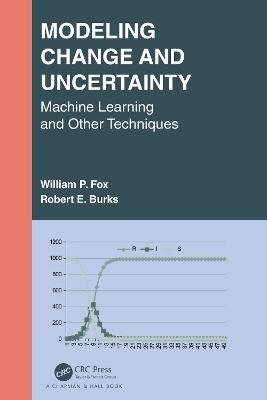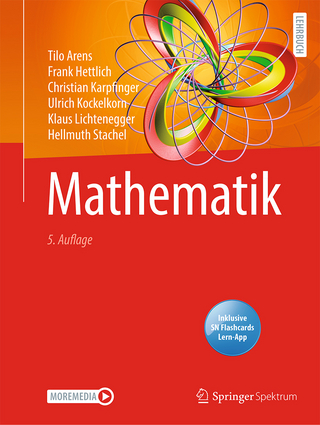
Modeling Change and Uncertainty
Chapman & Hall/CRC (Verlag)
978-1-032-06237-2 (ISBN)
This book offers a problem-solving approach. The authors introduce a problem to help motivate the learning of a particular mathematical modeling topic. The problem provides the issue or what is needed to solve using an appropriate modeling technique. Then principles are applied to the problem and present the steps in obtaining an appropriate model to solve the problem.
Modeling Change and Uncertainty:
Covers both linear and nonlinear models of discrete dynamical systems.
Introduces statistics and probability modeling.
Introduces critical statistical concepts to handle univariate and multivariate data.
Establishes a foundation in probability modeling.
Uses ordinary differential equations (ODEs) to develop a more robust solution to problems.
Uses linear programming and machine learning to support decision making.
Introduces the reality of uncertainty and randomness that is all around us.
Discusses the use of linear programing to solve common problems in modern industry.
Discusses he power and limitations of simulations.
Introduces the methods and formulas used in businesses and financial organizations.
Introduces valuable techniques using Excel, MAPLE, and R.
Mathematical modeling offers a framework for decision makers in all fields. This framework consists of four key components: the formulation process, the solution process, interpretation of the solution in the context of the actual problem, and sensitivity analysis.
Modeling Change and Uncertainty will be of interest to mathematics departments offering advanced mathematical modeling courses focused on decision making or discrete mathematical modeling and by undergraduate, graduate students and practitioners looking for an opportunity to develop, practice, and apply the craft of mathematical modeling.
Dr. William P. Fox is currently a visiting professor of Computational Operations Research at the College of William and Mary. He is an emeritus professor in the Department of Defense Analysis at the Naval Postgraduate School and teaches a three-course sequence in mathematical modeling for decision making. He received his Ph.D. in Industrial Engineering from Clemson University. He has taught at the United States Military Academy for twelve years until retiring and at Francis Marion University where he was the chair of mathematics for eight years. He has many publications and scholarly activities including twenty plus books and one hundred and fifty journal articles. Colonel (R) Robert E. Burks, Jr., Ph.D. is an Associate Professor in the Defense Analysis Department of the Naval Postgraduate School (NPS) and the Director of the NPS’ Wargaming Center. He holds a Ph.D. in Operations Research from the Air Force Institute of Technology. He is a retired logistics Army Colonel with more than thirty years of military experience in leadership, advanced analytics, decision modeling, and logistics operations who served as an Army Operations Research analyst at the Naval Postgraduate School, TRADOC Analysis Center, United States Military Academy, and the United States Army Recruiting Command. Other book by William P. Fox and Robert E. Burks: Advanced Mathematical Modeling with Technology, 2021, CRC Press. Other books by William P. Fox from CRC Press: Mathematical Modeling in the Age of the Pandemic, 2021, CRC Press. Advanced Problem Solving Using Maple: Applied Mathematics, Operations Research, Business Analytics, and Decision Analysis (w/William Bauldry), 2020, CRC Press. Mathematical Modeling with Excel (w/Brian Albright), 2020, CRC Press. Nonlinear Optimization: Models and Applications, 2020, CRC Press. Advanced Problem Solving with Maple: A First Course (w/William Bauldry), 2019. CRC Press. Mathematical Modeling for Business Analytics, 2018, CRC Press.
1. Perfect Partners: Combining Models of Change and Uncertainty with Technology. 1.1. Overview of the Process of Mathematical Modeling. 1.2. The Modeling Process. 1.3. Illustrative Examples. 1.4. Technology. 1.5. Exercises. 1.6. Projects. 1.7. References and Suggested Further Reading. 2. Modeling Change: Discrete Dynamical Systems (DDS) and Modeling Systems of DDS. 2.1. Introduction and Review of Modeling with Discrete Dynamical Systems. 2.2. Equilibrium and Stability Values and Long-Term Behavior. 2.3. Introduction to Systems of Discrete Dynamical Systems. 2.4. Iteration and Graphical Solution. 2.5. Modeling of Predator–prey Model, SIR Model, and Military Models. 2.6. Technology Examples for Discrete Dynamical Systems. 2.7. Exercises. 2.8. Projects. 2.9. References. 3. Statistical and Probabilistic Models. 3.1. Introduction. 3.2. Understanding Univariate & Multivariate Data. 3.3. Displays of Data and Statistics. 3.4. Statistical Measures. 3.5. Exercises. 3.6. References. 4. Modeling with Probability. 4.1. Classical Probability. 4.2. Bayes’ Theorem. 4.3. Discrete Distributions in Modeling. 4.4. Continuous Probability Models. 4.5. Confidence Intervals and Hypothesis Testing. 4.6. Exercises. 4.7. References. 5. Differential Equations. 5.1. Introduction. 5.1. Qualitative Assessment of Autonomous Systems of First Order Differential Equations. 5.2. Solving Homogeneous and Non-Homogeneous Systems. 5.3. Technology Examples for Systems of Ordinary Differential Equations. 5.4. Exercises. 5.5. Projects. 5.6. References and Suggested Future Readings. 6. Forecasting with Linear Programming and Machine Learning. 6.1. Introduction to Forecasting. 6.2. Machine Learning. 6.3. Model Fitting. 6.4. Time Series Models. 6.5. Case Studies of Time Series Data. 6.6. Summary and Conclusions. 6.7. References and Suggested Readings. 7. Stochastic Models and Markov Chains. 7.1. Introduction. 7.2. Transition Matrices. 7.3. Markov Chains and Bayes’ Theorem. 7.4. Markov Processes. 7.5. Exercises. 7.6. References. 8. Linear Programming. 8.1. Introduction. 8.2. Formulating Linear Programming Problems. 8.3. Technology Examples for Linear Programming. 8.4. Transportation and Assignment Problems. 8.5. Case Studies in Linear Programming. 8.6. Sensitivity Analysis in MAPLE. 8.7. Stochastic Optimization. 8.8. References. 9. Simulation of Queueing Models. 9.1. Introduction. 9.2. Queueing Model Practice Problems: Solutions. 9.3. Exercises. 9.4. References. 10. Modeling of Financial Analysis. 10.1. Introduction. 10.2. Simple and Compound Interest. 10.3. Rates of Interest, Discounting, and Depreciation. 10.4. Present Value. 10.5. Bond, Annuities, and Shrinking Funds. 10.6. Mortgages and Amortization. 10.7. Advanced Financial Models. 10.8. Exercises. 10.9. Projects. 10.10. References. 11. Reliability Models. 11.1. Introduction to Total Conflict (Zero-Sum) Games. 11.2. Modeling Component Reliability. 11.3. Modeling Series and Parallel Components. 11.4. Modeling Active Redundant Systems. 11.5. Modeling Standby Redundant Systems. 11.6. Models of Large-scale Systems. 11.7. Exercises. 11.8. References. 12. Machine Learning and Unconstrained Optimal Process. 12.1. Introduction. 12.2. The Gradient Method. 12.3. Machine Learning Regression: A Note on Complexity. 12.4. Genetic Algorithm as Machine Learning in R. 12.5. Initial Population. 12.6. Simulated Annealing. 12.7. Exercises. 12.8. References.
| Erscheinungsdatum | 01.07.2022 |
|---|---|
| Reihe/Serie | Textbooks in Mathematics |
| Zusatzinfo | 75 Tables, black and white; 204 Line drawings, black and white; 204 Illustrations, black and white |
| Sprache | englisch |
| Maße | 156 x 234 mm |
| Gewicht | 811 g |
| Themenwelt | Mathematik / Informatik ► Mathematik ► Analysis |
| Mathematik / Informatik ► Mathematik ► Angewandte Mathematik | |
| Technik ► Elektrotechnik / Energietechnik | |
| Technik ► Umwelttechnik / Biotechnologie | |
| ISBN-10 | 1-032-06237-1 / 1032062371 |
| ISBN-13 | 978-1-032-06237-2 / 9781032062372 |
| Zustand | Neuware |
| Informationen gemäß Produktsicherheitsverordnung (GPSR) | |
| Haben Sie eine Frage zum Produkt? |
aus dem Bereich


